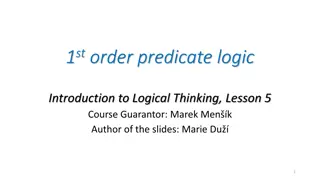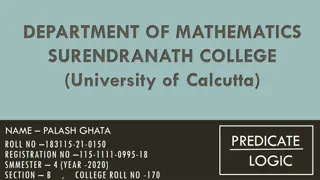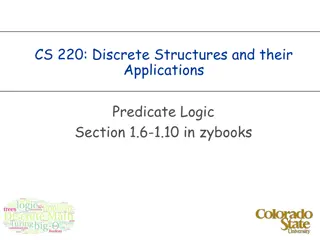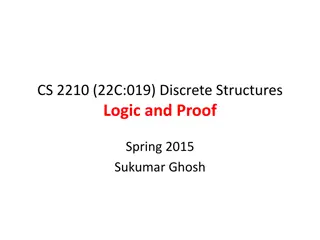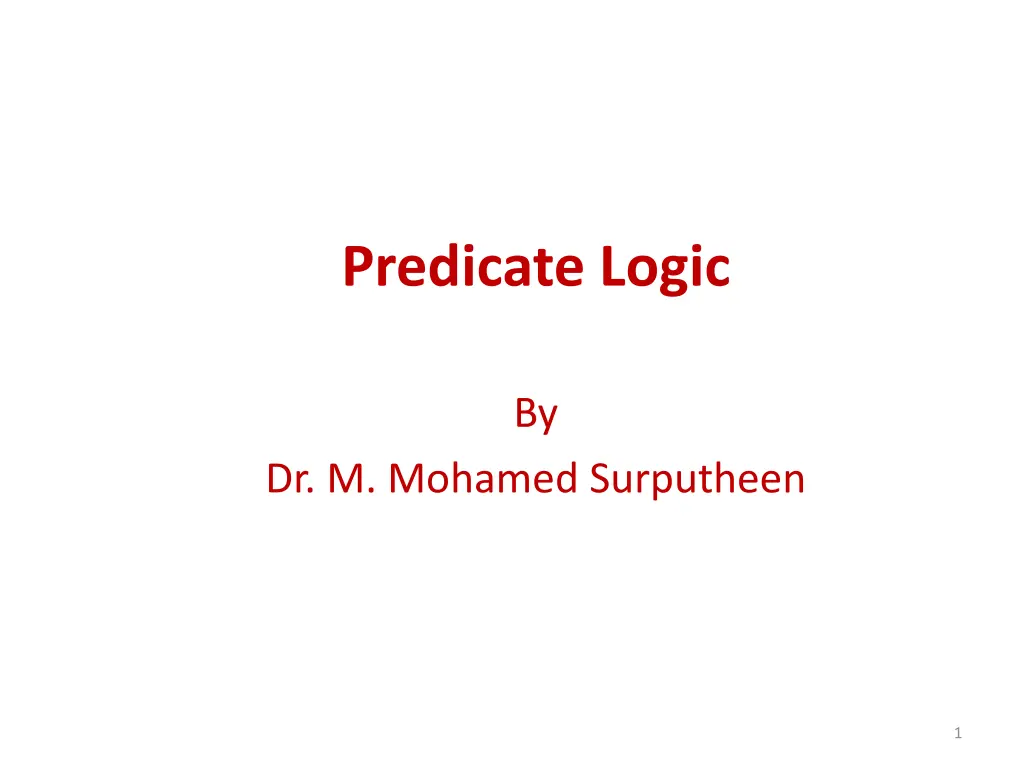
Understanding Predicate Logic and Standard Logic Symbols
Dive into the world of predicate logic and standard logic symbols with discussions on representing simple facts, real-world examples, and the differences between propositional and predicate logic. Explore how logical propositions are formulated and analyze various logical relationships.
Download Presentation

Please find below an Image/Link to download the presentation.
The content on the website is provided AS IS for your information and personal use only. It may not be sold, licensed, or shared on other websites without obtaining consent from the author. If you encounter any issues during the download, it is possible that the publisher has removed the file from their server.
You are allowed to download the files provided on this website for personal or commercial use, subject to the condition that they are used lawfully. All files are the property of their respective owners.
The content on the website is provided AS IS for your information and personal use only. It may not be sold, licensed, or shared on other websites without obtaining consent from the author.
E N D
Presentation Transcript
Predicate Logic By Dr. M. Mohamed Surputheen 1
Predicate Logic Standard Logic Symbols Representing simple facts in Logic Representing Instance and Isa relationships Computable functions and predicates Resolution Natural deduction 2
Standard Logic Symbols v Or Material Implication And There Exists For All Not 3
Representing Simple Facts in Logic Using propositional logic Represent real-world facts as logical propositions written as well-formed formulas (wff s) Examples: It is raining RAINING It is sunny SUNNY It is Windy WINDY If it is raining, then it is not sunny RAINING SUNNY 4
Representing Simple Facts in Logic . Examples Socrates is a man SOCRATESMAN Plato is a man PLATOMAN All men are mortal Can t draw any conclusion about similarities between Socrates and Plato MORTALMAN Can t capture the relationship between any individual being a man and that individual being a mortal 5
Representing Simple Facts in Logic . Using predicate logic Example: Socrates is a man Plato is a man All men are mortal man(socrates) man(plato) X (man(X) mortal(X)) => mortal(socrates) 6
Representing Simple Facts in Logic . Propositional logic vs. predicate logic Using propositional logic Theorem proving is decidable Cannot represent objects and quantification Using predicate logic Can represent objects and quantification Theorem proving is semi-decidable 7
Representing Simple Facts in Logic 1. Marcus was a man. 2. Marcus was a Pompeian. 3. All Pompeians were Romans. 4. Caesar was a ruler. 5. All Romans were either loyal to Caesar or hated him. 6. Every one is loyal to someone. 7. People only try to assassinate rulers they are not loyal to. 8. Marcus tried to assassinate Caesar 8
Representing Simple Facts in Logic 1. Marcus was a man. man(Marcus) 2. Marcus was a Pompeian. Pompeian(Marcus) 3. All Pompeians were Romans. x: Pompeian(x) Roman(x) 4. Caesar was a ruler. ruler(Caesar) 9
Representing Simple Facts in Logic 5. All Romans were either loyal to Caesar or hated him. inclusive-or x: Roman(x) loyalto(x, Caesar) hate(x, Caesar) exclusive-or (XOR) x: Roman(x) (loyalto(x, Caesar) hate(x, Caesar)) hate(x, Caesar))] (loyalto(x, Caesar) 10
Representing Simple Facts in Logic 6. Every one is loyal to someone. x: y: loyalto(x, y) y: x: loyalto(x, y) x: y: loyalto(y, x) 7. People only try to assassinate rulers they are not loyal to. x: y: person(x) ruler(y) tryassassinate(x, y) loyalto(x, y) 8. Marcus tried to assassinate Caesar. tryassassinate(Marcus, Caesar) 11
Representing Simple Facts in Logic Use these statements to answer the question. Was Marcus loyal to Caesar? To produce a formal proof, reasoning backward from the desired goal. (loyalto(Marcus,Caesar) This attempts fails, however, since there is no way to satisfy the goal person(Marcus). 12
Representing Simple Facts in Logic (loyalto(Marcus,Caesar) (7, substitution) person(Marcus) ruler(Caesar) tryassassinate(Marcus, Caesar) (4 ,Substituion) person(Marcus) tryassassinate(Marcus, Caesar) (8 ,substtution) person(Marcus) (9 substitution) man(Marcus) We can satify the goal and produce a proof that Marcus was not loyal to Caser. 9. All men are people X : (man(X) person(X)) 13
Representing Simple Facts in Logic Three important issues must be addressed in the process of converting English sentence into logical statements and using the those statements to deduce new ones. Many English sentences are ambiguous. Chossing the correct interpretation may be difficult. There is often a choice of how to represent knowledge. Obvious information may be necessary for reasoning. We may not know in advance which statements to deduce (P or P). 14
Representing Instance & Isa Relationships Pompeian(Marcus) x: Pompeian(x) Roman(x) instance(Marcus, Pompeian) x: instance(x, Pompeian) instance(x, Roman) instance(Marcus, Pompeian) isa(Pompeian, Roman) x: y: z: instance(x, y) isa(y, z) instance(x, z) 15
Make an Exception Example Paulus was a Pompeian. Paulus neither hate Caesar nor are loyal to him Pompeian(Paulus) [loyalto(Paulus, Caesar) v hate(Pualus, Caesar)] => make the knowledge base inconsistent 16
Make an Exception Solution: Modify the original assertion to which an exception is being made. loyalto(X, Caesar) v hate(X, Caesar) X: Roman(X) eq(X, Paulus) Problem arises when information is incomplete and it not possible that no exceptions apply in a particular instance. 17
Computable Functions and Predicates Computable predicates greater-than(1, 0) less-than(0, 1) greater-than(2, 1) less-than(1, 2) greater-than(3, 2) less-than(2, 3) . . Computable functions greater-than(2 + 3, 1) 18
Computable Functions and predicates Example Question: Is Marcus alive now? 19
Resolution Refutation proof procedure. Reduces some of the complexity because it operates on statements that have been converted to a single canonical form. To prove a statement , resolution attempts to show that the negation of statement produces a contradiction with the known statements. 21
Resolution in Propositional Logic Suppose a set of axioms(propositions) is given. Convert all propositions of this set to clause form. The resolution algorithm is given as follows. Algorithm for propositional resolution 1.Convert all propositions to clause form. 2.Negate P and convert the result to clause form. Add it to the set of clauses. 3.Repeat until either a contradiction is found or no progress is possible. (a) Take any two clauses as parent clauses. (b) Resolve these two clauses. The resulting clause is called resolvent. (c ) if the resolvent is empty clause then a contradiction is found. If not, then add resolvent to the set of clauses. Suppose following propositions are given and we have to prove R. 22
Resolution in Propositional Logic Example 23
Resolution in Predicate Logic Unification Algorithm To determine contradictions, a matching procedure that compares two literals and discovers there a set of substitutions that makes them identical. Covert to clause Form -Algorithm To use formula in a proof requires a complex matching process. The formula would be easier to work with if 1. It were flatter i.e., there was less embedding of components. 2. Quantifiers were separated from the rest of the so they did not need to be considered. Conjunctive normal form has both of these properties. 24
UNIFICATION Example The literals could be unified with any of the following substitutions: (Marcus/x, z/y) (Marcus/x, y/z) (Marcus/x, Caesar/y, Caesar/z) hate(x, y) hate(Marcus, z) (Marcus/x, Polonius/y, Polonius/z) 25
UNIFICATION The empty list, NIL, indicates that a match was found without any substitutions. The list consisting of the single value FAIL indicates that the unification procedure failed. Algorithm: Unify(L1, L2) I. If L1 or L2 are both variables or constants, then: (a) If L1 and L2 are identical, then return NIL. (b) Else if L1 is a variable, then if L1 occurs in L2 then return {FAIL}, else return (L2/L1). (c) Else if L2 is a variable, then if L2 occurs in L1 then return {FAIL}, else return (L1/L2). (d) Else return {FAIL}. 2. If the initial predicate symbols in L1 and L2 are not identical, then return {FAIL}. 3. If LI and L2 have a different number of arguments, then return {FAIL}. 4. Set SUBST to NIL. (At the end of this procedure, SUBST will contain all the substitutions used to unify L1 and L2.) 5. For i 1 to number of arguments in L1 : (a) Call Unify with the ith argument of L1 and the ith argument of L2, putting result in S. (b) If S contains FAIL then return {FAIL}. (c) If S is not equal to NIL then: (i) Apply S to the remainder of both L1 and L2. (ii) SUBST: = APPEND(S, SUBST). 6. Return SUBST. 26
Example All Romans who know Marcus either hate Caesar or think that anyone who hates anyone is crazy x, [ Roman(x) know(x, Marcus) ] [ hate(x, Caesar) ( y, z, hate(y, z) thinkCrazy(x, y))] 28
Step 1: Eliminate implications Use the fact that x y is equivalent to x y x, [ Roman(x) know(x, Marcus) ] [ hate(x, Caesar) ( y, z, hate(y, z) thinkCrazy(x, y))] x, [ Roman(x) know(x, Marcus) ] [hate(x, Caesar) ( y, ( z, hate(y, z) thinkCrazy(x, y))] 29
Step 2: Reduce the scope of Reduce the scope of negation to a single term, using: ( p) p (a b) ( a b) (a b) ( a b) x, p(x) x, p(x) x, p(x) x, p(x) x, [ Roman(x) know(x, Marcus) ] [hate(x, Caesar) ( y, ( z, hate(y, z) thinkCrazy(x, y))] x, [ Roman(x) know(x, Marcus) ] [hate(x, Caesar) ( y, z, hate(y, z) thinkCrazy(x, y))] 30
Step 3: Standardize variables apart x, P(x) x, Q(x) becomes x, P(x) y, Q(y) This is just to keep the scopes of variables from getting confused Not necessary in our running example 31
Step 4: Move quantifiers Move all quantifiers to the left, without changing their relative positions x, [ Roman(x) know(x, Marcus) ] [hate(x, Caesar) ( y, z, hate(y, z) thinkCrazy(x, y)] x, y, z,[ Roman(x) know(x, Marcus) ] [hate(x, Caesar) ( hate(y, z) thinkCrazy(x, y))] 32
Step 4: Move quantifiers Move all quantifiers to the left, without changing their relative positions x, [ Roman(x) know(x, Marcus) ] [hate(x, Caesar) ( y, z, hate(y, z) thinkCrazy(x, y)] x, y, z,[ Roman(x) know(x, Marcus) ] [hate(x, Caesar) ( hate(y, z) thinkCrazy(x, y))] 33
Step 5: Eliminate existential quantifiers We do this by introducing Skolem functions: If x, p(x) then just pick one; call it x If the existential quantifier is under control of a universal quantifier, then the picked value has to be a function of the universally quantified variable: If x, y, p(x, y) then x, p(x, y(x)) Not necessary in our running example 34
Step 6: Drop the prefix (quantifiers) x, y, z,[ Roman(x) know(x, Marcus) ] [hate(x, Caesar) ( hate(y, z) thinkCrazy(x, y))] At this point, all the quantifiers are universal quantifiers We can just take it for granted that all variables are universally quantified [ Roman(x) know(x, Marcus) ] [hate(x, Caesar) ( hate(y, z) thinkCrazy(x, y))] 35
Step 7: Create a conjunction of disjuncts [ Roman(x) know(x, Marcus) ] [hate(x, Caesar) ( hate(y, z) thinkCrazy(x, y))] becomes Roman(x) know(x, Marcus) hate(x, Caesar) hate(y, z) thinkCrazy(x, y) 36
Step 8: Create separate clauses Every place we have an , we break our expression up into separate pieces Not necessary in our running example 37
Step 9: Standardize apart Rename variables so that no two clauses have the same variable Not necessary in our running example Final result: Roman(x) know(x, Marcus) hate(x, Caesar) hate(y, z) thinkCrazy(x, y) That s it! It s a long process, but easy enough to do mechanically 38
Resolution in Predicate Logic 1. Marcus was a man. 2. Marcus was a Pompeian. 3. All Pompeians were Romans. 4. Caesar was a ruler. 5. All Romans were either loyal to Caesar or hated him. 6. Every one is loyal to someone. 7. People only try to assassinate rulers they are not loyal to. 8. Marcus tried to assassinate Caesar. Prove: Marcus hated Caesar. 39
Resolution in Predicate Logic 1. man(Marcus). 2. Pompeian(Marcus). 3. x: Pompeian(x) Roman(x). 4. ruler(Caesar). 5. x: Roman(x) loyalto(x, Caesar) hate(x, Caesar). 6. x: y: loyalto(x, y). 7. x: y: person(x) ruler(y) tryassassinate(x, y) loyalto(x, y). 8. tryassassinate(Marcus, Caesar). Prove: hate(Marcus, Caesar). 40
Proof Using New Representation What happened in 79 AD? To prove that something happened in 79 AD x :event(x, ) do not have any statements of the for event(x,y) Change our representation from erupted(volcano, 79) to Event(erupted (volcano),79) 48
Natural Deduction Problems with resolution The heuristic information contained in the original statements can be lost in the transformation. Example : All judges who are not crooked are educated. x: judge(x) crooked(x) educated(x) : This form suggests that some one judge(x) v crooked(x) v educated(x) : This form deduces that someone is is educated. not judge by showing that he is not cooked and not educated. It not best way to show that some is not a judge. People do not think in resolution. Natural deduction: A way of doing machine theorem proving that corresponds more closely to processes used in human theorem proving. 49





